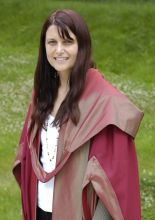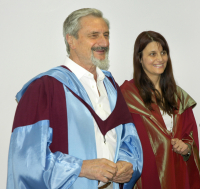 Cristina Gonzalez, who graduated from the University of Buenos Aires, recently passed her PhD viva at Wessex Institute of Technology with her thesis entitled ‘Electromagnetic Exposure to ELF electric fields using parametric models of the human body and the BEM’. The external examiner was Prof Jan Sykulski from the University of Southampton and the internal examiner was Prof Viktor Popov.
Cristina Gonzalez, who graduated from the University of Buenos Aires, recently passed her PhD viva at Wessex Institute of Technology with her thesis entitled ‘Electromagnetic Exposure to ELF electric fields using parametric models of the human body and the BEM’. The external examiner was Prof Jan Sykulski from the University of Southampton and the internal examiner was Prof Viktor Popov.
The research, supported by the Programme Alban of the European Union and WIT, was undertaken in the Information and Communications Engineering Division at WIT, and incorporated the field of adverse health effects due to electromagnetic pollution. The objective of the research was to develop new numerical approaches for modelling Low Frequency electromagnetic fields in the human body using the Boundary Element Method (BEM) and its hybridisation with other numerical techniques, providing more realistic modelling capabilities, higher accuracy and faster convergence rates than the existent algorithms.
The behaviour of electric fields and induced currents in the human body exposed to different scenarios of extremely low frequency (ELF) fields by means of numerical modelling with improved BEM was investigated. A variety of three dimensional anatomically shaped human body models, including a pregnant woman and foetus at different stages of pregnancy, was developed and exposure conditions for these models were examined. A new improved BEM approach was introduced in order to solve this type of problem, characterised by the high number of degrees of freedom and complicated by the definition of several sub-domains. This novel strategy, based on mixing continuous and discontinuous nodes and a new analytical integration scheme for the single and double layer potentials, helped to speed up the calculations in the pre-processing and assembly schemes with respect to the classical BEM, leading at the same time to more accurate results. In particular, the integration method maintained high accuracy even when the internal observation points approached the boundary of the domain. This method significantly improved the performance of the traditional BEM when applied to large scale problems with the Multi Domain approach.
 In all cases, a sensitivity analysis investigating the influence of varying geometrical and electrical properties of the tissues was conducted. The results obtained allowed the candidate to identify situations of high and low exposure in different parts of the body, including the foetus at different stages of pregnancy and compare with existing exposure guidelines.
In all cases, a sensitivity analysis investigating the influence of varying geometrical and electrical properties of the tissues was conducted. The results obtained allowed the candidate to identify situations of high and low exposure in different parts of the body, including the foetus at different stages of pregnancy and compare with existing exposure guidelines.
Cristina was congratulated by the examiners who both recommended the award of Doctor of Philosophy.
Cristina is now a new member of staff at BEASY.

 Wessex Institute
Wessex Institute